Finland's modest house price rises
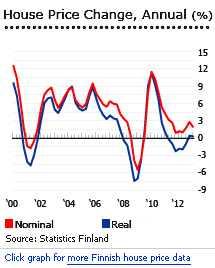 Finland’s housing market is stabilizing, despite its weakening economy.
Finland’s housing market is stabilizing, despite its weakening economy.
The price index of all dwellings rose 1.94% during the year to Q1 2013 (0.29% inflation-adjusted), according to Statistics Finland.
In May 2013, the average price of old dwellings rose 1.4% y-o-y, to €2,204 per square metre.
- In Greater Helsinki, the average price of old dwellings increased by 2.4%, to €3,505 per square metre (sq. m.) from a year earlier.
- In the rest of the country, the average price of old dwellings increased by 0.6% to €1,693 per sq. m. over the same period.
Blocks of flats in Finland rose by 2.5% to €2,338 per sq. m., with a stronger performance in Greater Helsinki, where prices rose by 3.8% to an average of €3,674 per sq. m. Terraced houses struggled, average prices dropping country-wide by 0.4%, to €1,994 per sq. m.
The demand data is mixed. Purchases of new dwellings rose by 3.3% y-o-y in Q1 2013 and purchases of existing dwellings increased by 1.5% over the same period. But in contrast the total number of building permits for dwellings dropped by 19% in April 2013 from a year earlier, to 2,331 units.
Residential property prices are expected to continue rising at a modest pace in 2013, according to local real estate experts, despite projections that the Finnish economy will contract by 0.4% in 2013, after shrinking 0.2% in 2012. Growth was 2.8% in 2011, and 3.3% in 2010.
Finland’s violent house price cycles
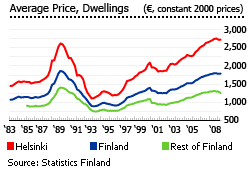
Finland’s house price boom lasted from 2001 to Q2 2008. The upsurge in house prices was mainly due to:
- Strong economic and wage growth.
- Changes in the mortgage market, combined with low interest rates, which made housing more affordable for all income brackets. Outstanding housing loans to Finnish households grew 153% from €24.3b illion in 2000, to €67.6 billion in 2008; or from 18.4% of GDP to 36.3% of GDP.
- The tax system. Owner-occupation is still privileged by the tax system, for despite reforms during the 1980s, a flat 29% tax deduction on mortgage interest remains in place, while imputed rental income and capital gains on permanent homes are untaxed.
From 1980 to the present, the country experienced four distinct house-price cycles:
INFLATION-ADJUSTED PRICE CHANGE OF EXISTING DWELLINGS |
|||
| Finland | Helsinki | Rest of Finland | |
| 1983 – 1989 | 64.0% | 68.5% | -- |
| 1989 – 1993 | -49.2% | -53.4% | -44.4% |
| 1993 – 1994 | 6.6% | 10.3% | 3.2% |
| 1994 -1995 | -4.8% | -6.3% | -1.9% |
| 1995 – 1999 | 45.0% | 62.8% | 38.0% |
| 1999 – 2001 | -6.9% | -5.5% | -12.0% |
| 2001 - Q2 2008 | 42.0% | 45.7% | 33.4% |
| Q2 -2008 – Q1 2009 | -6.4% | -8.6% | -4.0% |
| Source: Statistics Finland | |||

The relative volatility of house prices in Finland is mainly due to:
- the export-oriented economy’s sensitivity to global shocks;
- the housing market’s high interest rate sensitivity; and
- an insufficiently responsive supply side.
House prices are falling in Finland primarily because the two main causes of the house price boom (a strong economy, and low interest rates) no longer apply. But an additional factor is that the market has become more interest-rate sensitive:
- In 1994, about 70% of new mortgages were variable rate.
- Since 2001, more than 90% of new mortgages have been at variable rates, taking advantage of the historic low interest rates from 2003 to 2006.
The credit crunch
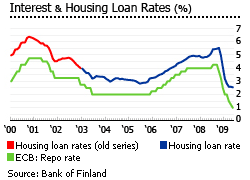
It was a severe shock to the housing market when interest rates on new loans rose in October 2008 to 5.53%, following a spike in inflation due to rising food import prices. The European Central Bank (ECB) had raised the repo rate by rapid steps to 4.25% in July 2008, from a record low of 2.0% in November 2005.
Combined with the global recession, these rate hikes soon set off a severe economic downturn across Europe, and in May 2009 the ECB was forced to bring the base rate down again to 1%. Finland’s average new housing loan mortgage rates fell to 2.55%.
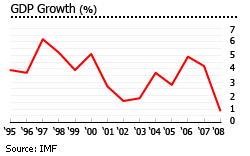
Yet during the first half of 2009, new mortgages ran at only €1.805 billion per month, down from €2.574 billion/month during the same period in 2008.
Finland’s long housing boom was encouraged by a decade of under-building. Less than 30,000 dwellings were completed annually from 1994 to 1999, down on 40,000 units annually from 1983 to 1991 (with a peak level of 65,397 units in 1990).

Around 58% of dwellings are owner-occupied, 32% are for rental while other forms of tenure account for the remaining 10%. Around 40% of new dwellings in Finland are bought by housing associations, and 35% by private individuals.
Low yields and subsidized-rents
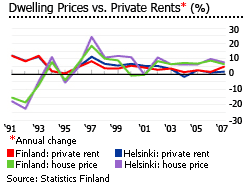
Finland’s private rental market is still relatively subdued, with about half of rental dwellings (about 800,000 units) receiving some form of government subsidy or support. Even with the complete deregulation of the private rental market in 1995, private rents are still distorted, due to the large social housing sector. Government subsidized rents are 25% lower than private rents in Helsinki, and 15% cheaper for Finland as a whole.
After the initial rapid rent increases after rent liberalization, recent rental growth has been slow. From 2001 to 2007, house prices in Finland rose by around 50%, while private rents trailed with growth of only 17%. In Helsinki, house prices rose 55% while private rents rose by only 12% over the same period. This has led to relatively low rental yields in Finland, ranging from 3.7% to 5.8% per annum in August 2008, according to the Global Property Guide.
In 2008, private rents rose 4.06% y-o-y, while government-subsidized rents rose by 5.3%.
In 2009 low inflation and weak demand, and a larger supply of units as home sellers lease out unsold second houses, are expected to moderate rent rises.
Finnish economy continues to weaken
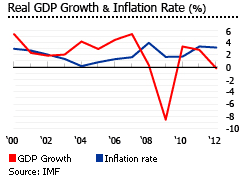
The Finnish economy was severely affected by the global downturn, contracting by 8.5% in 2009. There was a huge fiscal deficit, primarily due to a fall in tax revenue, growth in cyclical expenditure and central government stimulus measures. The economy bounced back strongly in 2012, with a real GDP growth rate of 3.3%. Then in 2011, the economy grew by a healthy 2.8%, according to the Ministry of Finance.
However, despite prudent fiscal policies, the eurozone debt crisis has dragged it into another recession. The Finnish economy shrunk by 0.2% in 2012, according to the Bank of Finland the country’s central bank. In the first quarter of 2013, the country’s GDP declined by 0.1% q-o-q and by 2.1% y-o-y, mainly due to a fall in exports of paper, machines and ships caused by weak European demand. The economy is projected to contract by another 0.4% in 2013.
Finland’s jobless rate increased to a four-year high of 10.8% in April 2013, from 8.8% in April 2012 and 9.5% in April 2011, based on figures from Statistics Finland. The overall unemployment rate is expected to rise to an average of 8.3% in 2013 from 7.7% in 2012, according to the Finance Ministry. Inflation is expected to be around 1.7% in 2013.
In 2012, the budget deficit stood at 1.9% of GDP, from 0.5% in 2011 and 2.5% in 2010. Finland’s budget deficit is expected at 1.5% of GDP in 2013, according to the Finnish government. The country’s government debt was equivalent to about 53% of GDP in 2012, up from 48.6% of GDP in 2011 and 48.4% of GDP in 2010.
Despite its worsening economic outlook, Finland is the only country in the eurozone to hold a triple-A credit rating with a stable outlook from all three international credit rating agencies.